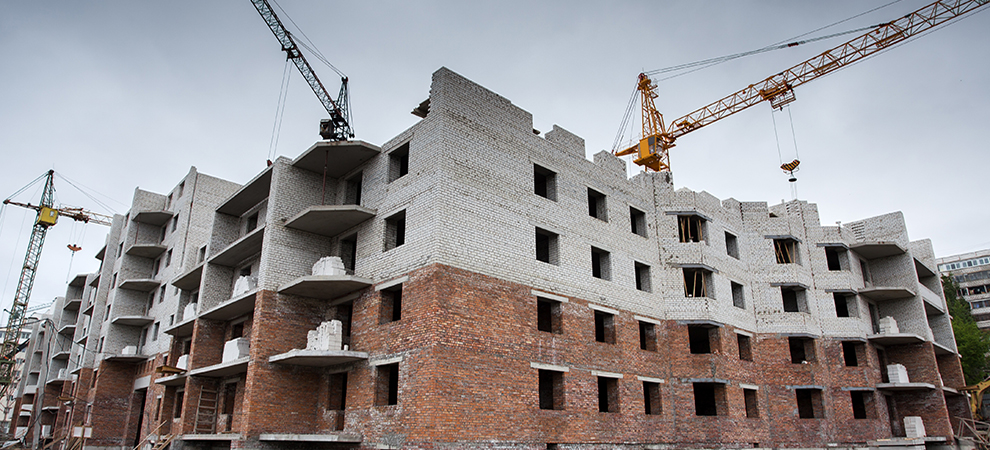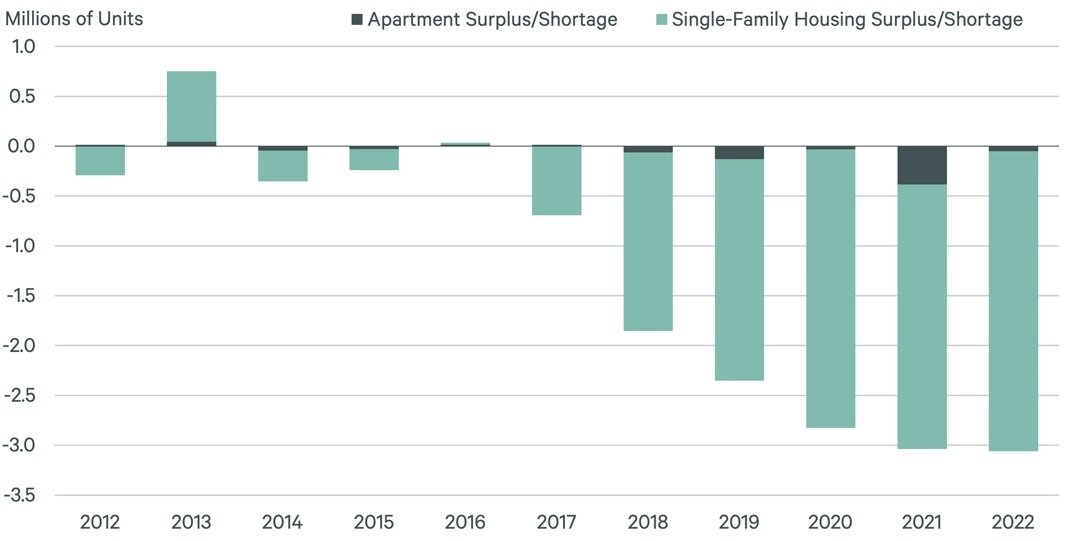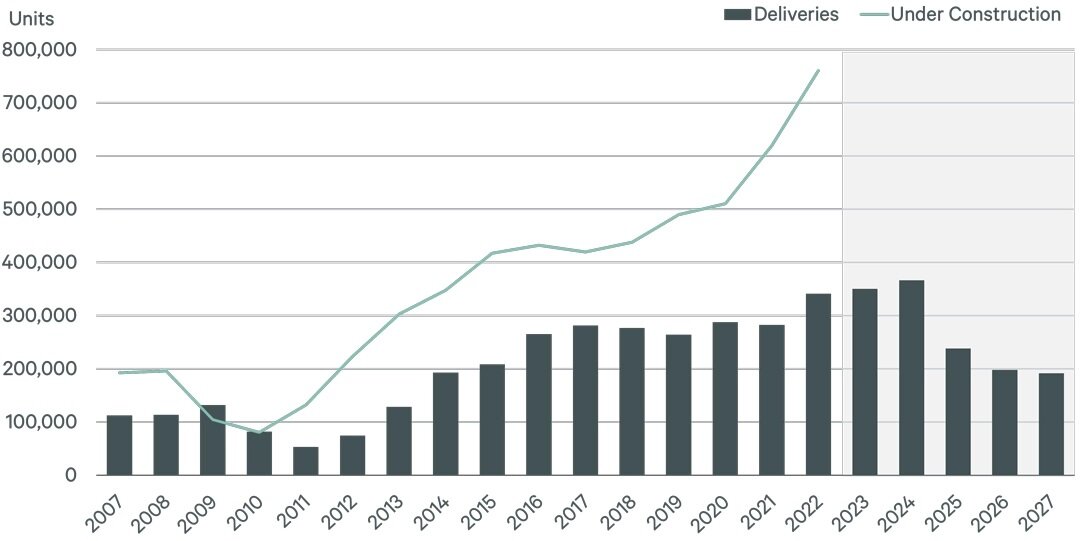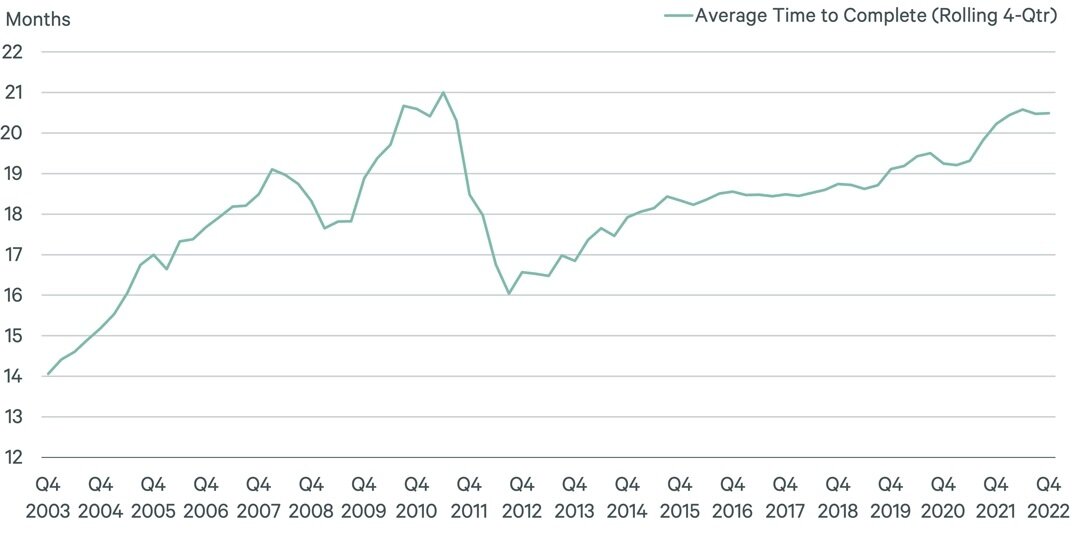Commercial Real Estate News

Multifamily Oversupply in U.S. Expected To Be Short-Lived
Commercial News » Orlando Edition | By Michael Gerrity | March 7, 2023 8:22 AM ET
According to the latest research from CBRE, while the delivery of a near-record 716,000 new multifamily housing units in the U.S. over the next two years will create a short-term oversupply, the new supply is needed to keep long-term fundamentals healthy in the sector.
The surge in construction is expected to push the multifamily sector's overall vacancy rate above equilibrium to a peak of 5.2% from 4.6% by year-end. While this may be surprising, given the overall housing shortage in the U.S., the lack of supply is predominantly in single-family homes and not multifamily units. CBRE expects that demand for rental housing will gain momentum this year as vacancy peaks only slightly above its long run average of 5.0%.
Even with a surplus of multifamily units over the short-term, CBRE forecasts that an additional 2.3 million new units will be needed nationwide to maintain healthy market fundamentals over the next 10 years. Once the largest portion of the delivery wave has concluded through 2024, the U.S. will still need nearly 200,000 additional units annually to maintain proper supply and demand balance.
"While a multifamily development surplus in the next 18 months may weigh on market fundamentals in the short-term, new deliveries will be limited beginning in 2025 and will ultimately lay the foundation for a healthy market throughout the next cycle," said Kelli Carhart, leader of Multifamily Capital Markets for CBRE in the U.S.
More than 750,000 multifamily units are currently under construction in the U.S.--the highest amount since the housing boom of the 1980s. Most of these new units are in markets such as Dallas, Austin and Atlanta that experienced the greatest in-migration during the COVID-19 pandemic. Although population growth in these markets is beginning to slow, the rapid increase in construction costs due to inflation and supply chain disruptions has caused multifamily starts to slow as well--meaning that the construction peak is likely occurring now.
The current wave in construction is expected to expand total multifamily inventory in the U.S. by 4.2% over the next two years. Although the sector has recorded negative net absorption--the net change in the total number of apartments leased--over the past three quarters, demand is expected to turn positive in the first half of 2023 and limit the extent to which rising vacancies could slow rent growth. While CBRE expects rent growth of 3.5% for the year--down from 6.7% in 2022 and 13.4% in 2021--this is still relatively healthy when compared with the long-run average of 2.5%
As the market returns to equilibrium, the potential for construction delays and extended timelines due to ongoing labor shortages could also limit the rise in vacancies. Early in the current construction cycle (2013) when the pipeline was approximately 300,000 units (less than half the amount today), the average time of construction from start to finish averaged 16.5 months. Today, that timeline averages 20.5 months--nearly 25% longer. The biggest jump in that expanded timeline occurred in 2021, when units under construction ramped up tremendously.
Sign Up Free | The WPJ Weekly Newsletter
Relevant real estate news.
Actionable market intelligence.
Right to your inbox every week.
Real Estate Listings Showcase
Related News Stories
Commercial Real Estate Headlines
- U.S. Commercial Mortgage Delinquencies Rise in Q2, CMBS Loans Lead the Surge
- Tokenization-Focused Real Estate Investment Bank Announced
- Commercial Cap Rates Edge Lower in U.S., Hinting at Market Turn
- WPV Targets New $6 Trillion Digital Real Estate Tokenization Opportunity
- $1 Trillion in Data Center Development Underway Through 2030
- WORLD PROPERTY VENTURES: The 'Anti-VC' of Real Estate Plans Major Capital Raise
- Multifamily Sector Enjoys Record Absorption in U.S. as Supply Slows, Vacancies Drop
- Employee Back-to-Office Attendance Surges in U.S.
- Phnom Penh Commercial Property Sectors Face Crosswinds in 2025
- World Property Bank Announced to Capitalize on Coming Trillion-Dollar Tokenization Boom
- REAL ESTATE PREDICTIONS: Decentralized Events Contract Exchange in Development
- U.S. Architecture Billings Improve Slightly in May
- Tokyo Office Demand Spills into Non-Core Wards in 2025
- AI Hyperscalers Drive Record Data Center Leasing in Early 2025
- Commercial, Multifamily Mortgage Debt in U.S. Hits Record $4.81 Trillion in Early 2025
- U.S. Multifamily Market Rebounds in Early 2025
- U.S. Office Market Experiences Historic Conversion Shift
- New York City Enters New Era of Office-to-Residential Conversions
- World Property Ventures Plans New Capital Raise
- U.S. Commercial Real Estate Lending Rebounds Sharply in Early 2025
- U.S. Multifamily Housing Confidence Declines in Early 2025
- Asia Pacific Commercial Investment Holds Steady in Early 2025
- Carnival Plans New Miami Headquarters Spanning Over 600,000 Square Feet
- Hong Kong Property Investors Take a Wait-and-See Approach Due to U.S. Tariffs
- U.S. Multifamily Buyer and Seller Sentiment Improves in Early 2025
- One Trillion Dollars of America's Commercial Property Loans Mature in 2025
- U.S. West Coast Dominates Self Storage Demand
- Phoenix, Orange County and Inland Empire Emerge as Leading U.S. Industrial Markets
- U.S. Mega Distribution Centers Leasing Activity Grew in 2024
- U.S. Commercial Borrowing to Increase to $583 Billion in 2025, Up 16 Percent Annually
- Demand for U.S. Life Sciences Space Spikes 28 Percent Annually in Late 2024
- Multifamily Property Sector in America Rebounding
- Asia Pacific Commercial Property Investment Spikes 23 Percent in 2024
- U.S. Commercial Property Market Primed for Growth in 2025
- Architecture Industry Sees Mixed Signals as 2025 Approaches
- Global Data Center Demand Spikes in 2025
- 2025 Prediction: U.S. Commercial Investment Recovery Expected to Gain Traction
- Holiday Retail Sales for 2024 to Hit Record $1 Trillion
- Tech, AI Industries Drive Largest Share of Office Leasing Activity in U.S.
- Commercial Real Estate Lending in U.S. Enjoys Strong Growth in Q3










